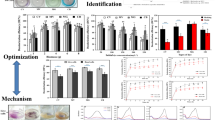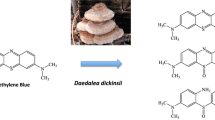Summary
A strain ofMyrothecium verrucaria that showed a high capacity for rapid decolorization of textile dye solutions was isolated from soil. As much as 70%, 86%, and 95% of Orange II, 10B (blue) and RS (red) dyes (color index no. 15510, 20470, 23635), respectively, were adsorbed from solutions of approximately 0.2 g dye per liter in 5 h by approximately 4.5 g dry weight of cells per liter of dye solution. Intact cells showed a higher adsorption capacity than disrupted cells for Orange II and RS but not for 10B. Dye bound to cells was recoverable by extraction with methanol and methanol-treated cells were able to be recycled, albeit with a slightly diminished dye-binding capacity. The Tween detergents were shown to reduce dye adsorption. Dyes strongly bound to the fungal biomass required sonication in dH2O or in Triton X-100 or extraction with methanol for their removal. These results suggest that hydrophobic/hydrophilic interactions are important in dye binding.
Similar content being viewed by others
References
Cripps, C., J.A. Bumpus and S.D. Aust. 1990. Biodegradation of azo and heterocyclic dyes byPhanerochaete chrysosporium. Appl. Environ. Microbiol. 56: 1114–1118.
Glenn, J.K. and M.H. Gold. 1983. Decolorization of several polymeric dyes by the lignin-degrading basidomycetePhanerochaete chrysosporium. Appl. Environ. Microbiol. 45: 1741–1747.
Groff, K.A. and B.R. Kim. 1989. Textile Wastes. J. Water Pollut. Control Fed. 61: 872–876.
Mechsner, K. and K. Wuhrmann. 1982. Cell permeability as a rate limiting factor in the microbial reduction of sulfonated azo dyes. Eur. J. Appl. Microbiol. Biotechnol. 15: 123–126.
Mou, D.-G., K.-K. Lim and H.-P. Shen. 1991. Microbial agents for decclorization of dye wastewater. Biotechnol. Adv. 9: 613–622.
Okeke, C.N. and B.N. Okolo. 1990. The effect of cultural conditions on the production of lipase byAcremonium strictum. Biotechnol. Lett. 12: 747–750.
Paszczynski, A., M.B. Pasti, S. Goszczynski, D.L. Crawford and R.L. Crawford. 1991. New approach to improve degradation of recalcitrant azo dyes byStreptomyces spp. andPhanerochaete chrysosporium. Enzyme Microbiol. Technol. 13: 378–383.
Preston, N.C. 1943. Observations on the genusMyrothecium Tode I. The three classic species. Trans. Br. Mycol. Soc: 158–168.
Shaul, G.M., T.J. Holdsworth, C.R. Dempsey and K.A. Dostal. 1991. Fate of water soluble azo dyes in the activated sludge process. Chemosphere 22: 107–119.
Skopes, R.K. 1982. Protein Purification. Springer-Verlag, New York.
Walker, R. 1970. The metabolism of azo compounds: a review of the literature. Food Cosmet. Toxicol. 8: 659–676.
Wuhrmann K., Mechsner K. and T. Kappeler. 1980. Investigation on rate-determining factors in the microbial reduction of azo dyes. Eur. J. Appl. Microbiol. Biotechnol. 9: 325–338.
Zimmermann, T., H.G. Kulla and T. Leisinger. 1982. Properties of purified Orange II azoreductase, the enzyme initiating azo dye degradation byPseudomonas KF46. Eur. J. Biochem. 129: 197–203.
Colour Index, 3rd edn., Society of Dyes and Colourists, West Yorkshire and the American Association of Textile Chemists and Colorists, Research Triangle Park, NC, 1971.
Author information
Authors and Affiliations
Rights and permissions
About this article
Cite this article
Brahimi-Horn, MC., Lim, KK., Liang, SL. et al. Binding of textile azo dyes byMyrothecium verrucaria . Journal of Industrial Microbiology 10, 31–36 (1992). https://doi.org/10.1007/BF01583631
Received:
Revised:
Accepted:
Issue Date:
DOI: https://doi.org/10.1007/BF01583631




